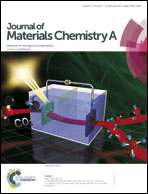Stiff metal–organic framework–polyacrylonitrile hollow fiber composite membranes with high gas permeability†
Abstract
Metal–organic framework (MOF) membranes used for gas separation have attracted considerable attention recently. Although there are studies focusing on their continuous growth on inorganic substrates, MOF–polymer membranes are in demand because of their low cost, high processing ability and large membrane area. To achieve this purpose, the flexibility of the polymer must be reduced and the MOF-to-substrate adhesion strength should be greatly enhanced. Herein, a continuous and well inter-grown Cu3(BTC)2–PAN composite membrane has been successfully fabricated by directly growing via a covalent linker. Dehydrogenation, cyclization and crosslinking reactions of the PAN hollow fiber by solvothermal treatment can greatly improve the stiffness and compression strength of the composite membrane. To increase the adhesion strength effectively, a covalent linker between the MOF layer and PAN substrate is provided by chemical modification. The prepared membrane achieves a high H2 permeance of 7.05 × 10−5 mol (m−2 s−1 Pa−1) and a good separation factor of 7.14 for binary H2–CO2 mixtures with high thermal and pressure stability. Our strategy has also been developed for preparing a continuous and well inter-grown ZIF-8–PAN membrane. A very thin ZIF-8 layer is finally synthesized due to the large number of nucleation sites on the substrate. All of these distinguished properties suggest that MOF–PAN composite membranes fabricated by chemical modification are promising candidates for gas separation.


 Please wait while we load your content...
Please wait while we load your content...